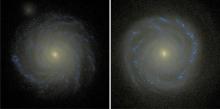
Abstract
Cosmological simulations of galaxy formation can produce present-day galaxies with a large range of assembly and star formation histories. A detailed study of the metallicity evolution and star formation history of such simulations can assist in predicting LIGO-detectable compact object binary mergers. Recent simulations of compact binary evolution suggest the compact object merger rate depends sensitively on the progenitor's metallicity. Rare low-metallicity star formation during galaxy assembly can produce more detected compact binaries than typical star formation. Using detailed simulations of galaxy and chemical evolution, we determine how sensitively the compact binary populations of galaxies with similar present-day appearance depend on the details of their assembly. We also demonstrate by concrete example the extent to which dwarf galaxies overabundantly produce compact binary mergers, particularly binary black holes, relative to more massive galaxies. We discuss the implications for transient multimessenger astronomy with compact binary sources.